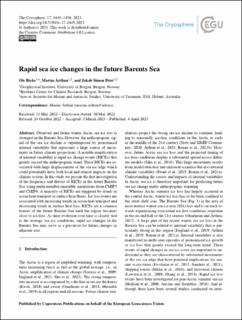| dc.contributor.author | Rieke, Ole | |
| dc.contributor.author | Årthun, Marius | |
| dc.contributor.author | Dörr, Jakob Simon | |
| dc.date.accessioned | 2023-04-24T11:24:40Z | |
| dc.date.available | 2023-04-24T11:24:40Z | |
| dc.date.created | 2023-04-11T11:09:57Z | |
| dc.date.issued | 2023 | |
| dc.identifier.issn | 1994-0416 | |
| dc.identifier.uri | https://hdl.handle.net/11250/3064497 | |
| dc.description.abstract | Observed and future winter Arctic sea ice loss is strongest in the Barents Sea. However, the anthropogenic signal of the sea ice decline is superimposed by pronounced internal variability that represents a large source of uncertainty in future climate projections. A notable manifestation of internal variability is rapid ice change events (RICEs) that greatly exceed the anthropogenic trend. These RICEs are associated with large displacements of the sea ice edge which could potentially have both local and remote impacts on the climate system. In this study we present the first investigation of the frequency and drivers of RICEs in the future Barents Sea, using multi-member ensemble simulations from CMIP5 and CMIP6. A majority of RICEs are triggered by trends in ocean heat transport or surface heat fluxes. Ice loss events are associated with increasing trends in ocean heat transport and decreasing trends in surface heat loss. RICEs are a common feature of the future Barents Sea until the region becomes close to ice-free. As their evolution over time is closely tied to the average sea ice conditions, rapid ice changes in the Barents Sea may serve as a precursor for future changes in adjacent seas. | en_US |
| dc.language.iso | eng | en_US |
| dc.publisher | Copernicus Publications | en_US |
| dc.rights | Navngivelse 4.0 Internasjonal | * |
| dc.rights.uri | http://creativecommons.org/licenses/by/4.0/deed.no | * |
| dc.title | Rapid sea ice changes in the future Barents Sea | en_US |
| dc.type | Journal article | en_US |
| dc.type | Peer reviewed | en_US |
| dc.description.version | publishedVersion | en_US |
| dc.rights.holder | Copyright 2023 The Author(s) | en_US |
| cristin.ispublished | true | |
| cristin.fulltext | original | |
| cristin.qualitycode | 2 | |
| dc.identifier.doi | https://doi.org/10.5194/tc-17-1445-2023 | |
| dc.identifier.cristin | 2139893 | |
| dc.source.journal | The Cryosphere | en_US |
| dc.source.pagenumber | 1445-1456 | en_US |
| dc.relation.project | Trond Mohn stiftelse: BFS2018TMT01 | en_US |
| dc.relation.project | Norges forskningsråd: 276730 | en_US |
| dc.identifier.citation | The Cryosphere. 2023, 17, 1445-1456. | en_US |
| dc.source.volume | 17 | en_US |

